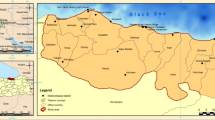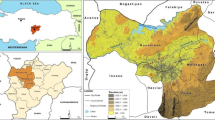Abstract
Thermal comfort is usually calculated using discrete point measurements. This procedure is not suitable to study thermal comfort for inhabited areas with rugged terrains where climate gradient is high. The wide availability of remote sensing data and GIS tools has revolutionized data management, processing, and visualization. The present paper implemented digital elevation data, GIS tools, and a computational algorithm to generate spatially continuous maps of climatological elements which were employed to derive thermal comfort levels across Jordan. Results show detailed information of the spatial distribution of the degree of thermal comfort in winter and summer across the country which cannot be resolved using discrete point measurements. It is shown that most mountainous areas in the country, where most urban centers are situated, experience “slightly warm” to “warm” indoor apparent temperatures in summer in 50% of the diurnal cycle. The Jordan Valley and the desert experience high indoor apparent temperatures in summer with warm and hot conditions for the most part of the diurnal cycle. Cold conditions prevail over most parts of the country in winter, with the heating degree days ranging from 2200 in the southern mountains to values close to zero near the Dead Sea area. Mountainous and desert areas experience cold or very cold conditions in more than 75% of the diurnal cycle. The presented procedure demonstrated that the very low levels of ambient vapor pressure is an important atmospheric forcing contributing to the widespread cold conditions prevailing over the desert areas in winter. The efficiency of direct evaporative cooling systems to achieve thermal comfort in the various parts of the country is investigated. The procedure presented can be used over regional scales with different levels of spatial resolutions for a wide range of climatological studies.










Similar content being viewed by others
Data availability
Data can be supplied upon request.
References
Alexandersson H (1986) A homogeneity test applied to precipitation data. J Climatology 6:661–675. https://doi.org/10.1002/joc.3370060607
Alexandersson H, Moberg A (1997) Homogenization of Swedish temperature data. Part I: homogeneity test for linear trends. International J Climatol 17:25–34
Anderson GB, Bell ML, Peng RD (2013) Methods to calculate the heat index as an exposure metric in environmental health research. Environ Health Perspect 121:1111–1119. https://doi.org/10.1289/ehp.1206273
Apaydin H, Sonmez FK, Yildirim YE (2004) Spatial interpolation techniques for climate data in the GAP region in Turkey. Climate Res 28:31–40
ASHRAE (2009) Handbook—Fundamentals. American Society of Heating, Refrigerating and Air-Conditioning Engineers Inc, Atlanta
Basediya A, Samuel V, Beera V (2013) Evaporative cooling system for storage of fruits and vegetables - a review. J Food Sci Technol 50(3):429–442. https://doi.org/10.1007/s13197-011-0311-6
Blazejczyk K, Epstein Y, Jendritzky G, Staiger H, Tinz B (2010) Comparison of UTCI to selected thermal indices. Int J Biometeorol 56:515–535. https://doi.org/10.1007/s00484-011-0453-2
Brager, Gail S.; de Dear, Richard J. (1998).. “Energy and Buildings”.27 (1): 83–96. https://doi.org/10.1016/S0378-7788(97)00053-4. ISSN 0378–7788.
Camargo JR (2007) Evaporative cooling: water for thermal comfort An Interdisciplinary. J Applied Sci 3:51–61
De Dear RJ, Brager GS (2002) Thermal comfort in naturally ventilated buildings: revisions to ASHRAE Standard 55. Energy and Buildings 34(6):549–561
Emmendorfer L.R., Dimuro G.P. (2020) A novel formulation for inverse distance weighting from weighted linear regression. In: Krzhizhanovskaya V. et al. (eds) Computational Science – ICCS 2020. ICCS 2020. Lecture Notes in Computer Science, vol. 12138. Springer, Cham. https://doi.org/10.1007/978-3-030-50417-5_43
Fabbri, K., 2015. A brief history of thermal comfort: from effective temperature to adaptive thermal comforthttps://doi.org/10.1007/978-3-319-18651-1_2 (in:indoorthermalcomfortperception)
Fang L, Wyon DP, Clausen G, Fanger PO (2004) Impact of indoor air temperature and humidity in an office on perceived air quality, SBS symptoms and performance. Indoor Air 14(Suppl 7):74–81. https://doi.org/10.1111/j.1600-0668.2004.00276.x
Fergus, N., (2001) Characterizing occupant behavior in buildings, Proceedings of the Seventh International IBPSA Conference. Rio de Janeiro, Brazil. pp. 1073–1078
Humphreys M, Nicol F (2000) Outdoor temperature and indoor thermal comfort: raising the precision of the relationship for the 1998 ASHRAE Database of Field Studies, ASHRAE Symposia, publication/284652345
Jeffrey S, Carter J, Moodie K, Beswick A (2001) Using spatial interpolation to construct a comprehensive archive of Australian climate data. Environ Model Softw 16:309–330
Marx W., Haunschild R, Bornmann L. (2021) Heat waves: a hot topic in climate change research., Theor. Appl. Climatol. 2021 Sep 3:1–20. https://doi.org/10.1007/s00704-021-03758-y
Matzarakis A., Amelung, B (2008) Physiological equivalent temperature as indicator for impacts of climate change on thermal comfort of humans, in M.C. Thomson et al. (eds.), Seasonal forecasts, climatic change and human health, Springer Science
Mistry M (2020) A high spatiotemporal resolution global gridded dataset of historical human discomfort indices. Atmosphere 11:835. https://doi.org/10.3390/atmos11080835
Oliveira S, Andrade H (2007) An initial assessment of the bioclimatic comfort in an outdoor public space in Lisbon. Int J Biometeorol 52:69–84. https://doi.org/10.1007/s00484-007-0100-0
Orimoloye I, Mazinyo S, Nel W, Iortyom E (2017) Climate variability and heat stress index have increasing potential Ill-health and environmental impacts in the East London, South Africa. Int J Appl Eng Res 12:6910–6918
Orosa JA (2009) On the origins of thermal comfort. Eur J Sci Res 34(4):561–567
Oroud IM (1997) Diurnal evaporation from fresh and hypersaline shallow ponds in a hot, dry environment. Phys Geogr 18(4):363–382
Oroud IM (2011) Evaporation from the Dead Sea and its implications on its water balance, theoretical and applied climatology. https://doi.org/10.1007/S00704-0452-6.
Oroud IM (2020) Spatial and temporal surface temperature patterns across the Dead Sea as investigated from thermal images and thermodynamic concepts. Theor Appl Climatol 142(1–2):569–579. https://doi.org/10.1007/s00704-020-03343-9
Panofsky H, Brier C (1968) Some applications of statistics to meteorology. University Park, Pennsylvania
Schlatter T.W. (1987) Temperature-humidity index. In: climatology. Encyclopedia of Earth Science. Springer, Boston, MA. https://doi.org/10.1007/0-387
Schweiker M, Fuchs X, Becker S, Shukuya M, Dovjak M, Hawighorst M, Kolarik J (2017) Challenging the assumptions for thermal sensation scales. Building Research and Information 45(5):572–589. https://doi.org/10.1080/09613218.2016.1183185
Steadman RG (1979a) The assessment of sultriness. Part I: a temperature-humidity index based on human physiology and clothing science. J Appl Meteorol 18(7): 861–873. https://doi.org/10.1175/1520-04501
Steadman RG (1979b) The assessment of sultriness. Part II: effects of wind, extra radiation and barometric pressure on apparent temperature. J Appl Meteorol 18(7):874–885. https://doi.org/10.1175/1520-04502
Steadman RG (1984) A universal scale of apparent temperature. J. Climate AM 23:1674–687
Stull R (2011) Wet-bulb temperature from relative humidity and air temperature. J Appl Meteorol Climatol 50:2267–2269
Tseliou A, Tsiros I, Lykoudis S, Nikolopoulou M (2010) An evaluation of three biometeorological indices for human thermal comfort in urban outdoor areas under real climatic conditions. Build Environ 45(2010):1346–1352. https://doi.org/10.1016/j.buildenv.2009.11.009
Yan Y, Xu Y, Yue S (2021) A high-spatial-resolution dataset of human thermal stress indices over South and East Asia. Scientific Data 1(8):229. https://doi.org/10.1038/s41597-021-01010-w
Funding
Financial support to author was provided by Mu’tah University, Jordan: Grant no. 2019/21.
Author information
Authors and Affiliations
Corresponding author
Ethics declarations
Ethics approval
Not applicable.
Consent to participate
Not applicable.
Consent for publication
I grant the Publisher an exclusive license to publish the article and transfer copyright of the article to the Publisher.
Competing interests
The author declares no competing interests.
Additional information
Publisher's note
Springer Nature remains neutral with regard to jurisdictional claims in published maps and institutional affiliations.
Rights and permissions
About this article
Cite this article
Oroud, I.M. Derivation of spatially distributed thermal comfort levels in Jordan as investigated from remote sensing, GIS tools, and computational methods. Theor Appl Climatol 148, 569–583 (2022). https://doi.org/10.1007/s00704-022-03951-7
Received:
Accepted:
Published:
Issue Date:
DOI: https://doi.org/10.1007/s00704-022-03951-7




